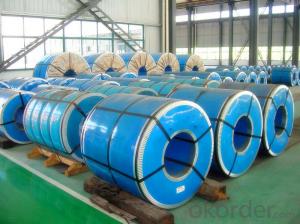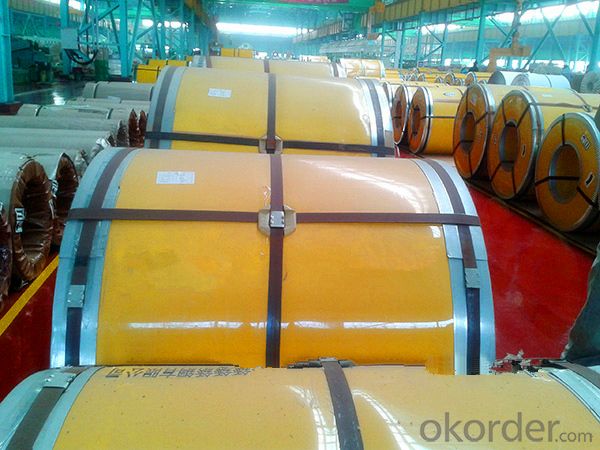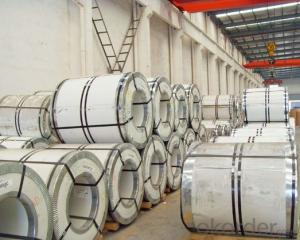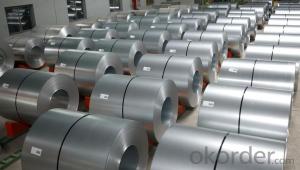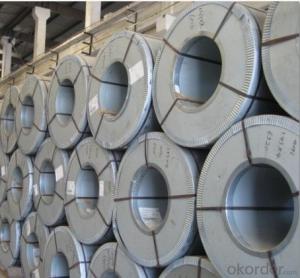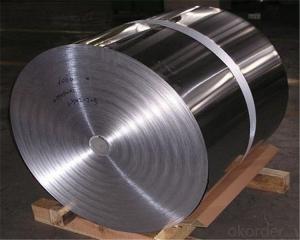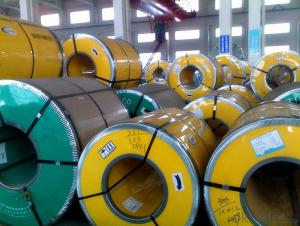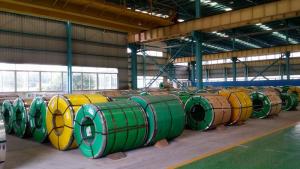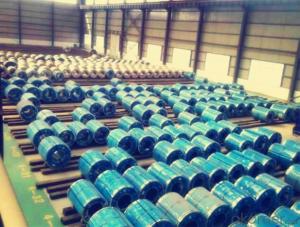Stainless Steel Coil 304 Cold Rolled Surface 2B with High Quality
- Loading Port:
- Guangzhou
- Payment Terms:
- TT OR LC
- Min Order Qty:
- 100 m.t.
- Supply Capability:
- 20000 m.t./month
OKorder Service Pledge
OKorder Financial Service
You Might Also Like
1.Structure of Stainless Steel Coil Cold Rolled 304 With Good Quality
Cold Rolled stainless steel Coil with good quality is one of the raw material of the cold rolled stainless steel Coil,
which can be used directly in many places. Stainless Steel (Stainless Steel) is short for acid proof Stainless Steel, resistant to weak corrosive medium such as air, steam, water, or with a Stainless Steel grade.
2.Main Features of Prefabricated Steel Structure High Building Project
Corrosion resistance The vast majority of stainless steel products for corrosion resistant performance is good, like a, 2 kinds of tableware,
kitchen utensils and appliances, water heaters, water dispensers, etc., some foreign businessmen on corrosion resistance of products
also do experiment: in NACL aqueous solution heated to boiling, after a period of time the best solution, wash and drying, weight loss,
to determine the degree of corrosion (note: the product polishing, because of the sand cloth or sandpaper containing Fe, will cause the
test surface rust spots)
3. Stainless Steel Coil Cold Rolled 304 With Good Quality Images
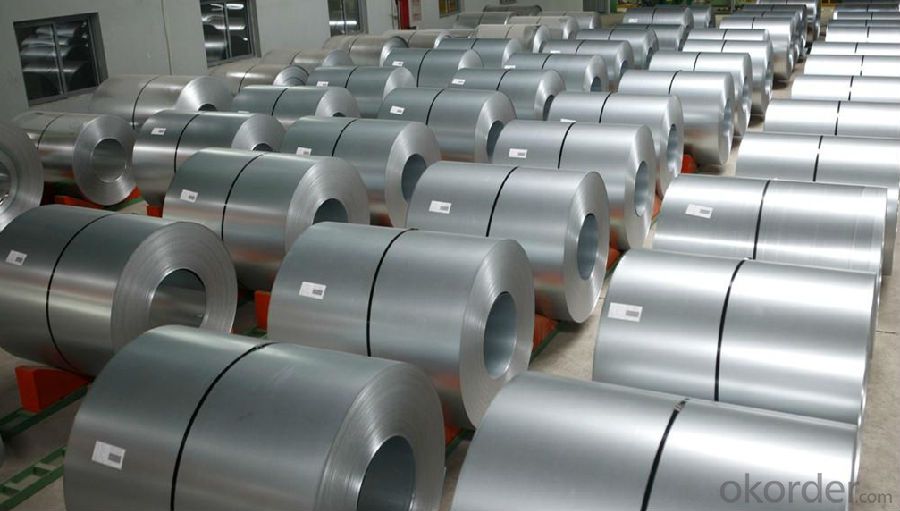

4. Stainless Steel Coil Cold Rolled 304 With Good Quality Specification
The word "stainless steel" is not merely refers to a pure stainless steel, but said more than one hundred kinds of stainless steel
industry, the development of each stainless steel has good performance in their specific applications. The key to the success of
the first is to make clear purpose, and then determine the correct material. Related to architectural construction applications usually
only six types of steel. They contain 17 ~ 22% chromium, good steel contains nickel. Add molybdenum can further improve the
atmospheric corrosion resistance, especially containing chloride atmospheric corrosion resistance. Stainless steel often according
to the state of organization can be divided into: martensite steel, ferritic steel, austenitic steel, austenitic (twophase) - ferrite stainless
steel and precipitation hardening stainless steel, etc. In addition, according to ingredients can be divided into: chromium stainless
steel, chromium nickel stainless steel and chromium manganese nitrogen stainless steel, etc.
5. Applications of Stainless Steel Coil 304 With Good Quality
1. Kitchenware: tableware, cookware, Stoves…
2. Food packing: storage cans, food containers…
3. Construction: bridge, roofing, wall, decoration, bathroom accessories…
4. Precision instruments: electrical products, aerospace…
5. Others: automotive parts, machine building, chemical processing, farming…
6.FAQ of Stainless Steel Coil 304 With Good Quality
We have organized several common questions for our clients,may help you sincerely:
①How about your company?
A world class manufacturer & supplier of castings forging in carbon steel and alloy steel,is one of the large-scale professional investment casting production bases in China,consisting of both casting foundry forging and machining factory.
Annually more than 8000 tons Precision casting and forging parts are exported to markets in Europe,America and Japan. OEM
casting and forging service available according to customer’s requirements.
②How to guarantee the quality of the products?
We have established the international advanced quality management system,every link from raw material to final product we have strict
quality test;We resolutely put an end to unqualified products flowing into the market. At the same time, we will provide necessary
follow-up service assurance.
③How is the packaging and delivery?
Standard export packing (Coil: waterproof paper + protective steel ring; Circle: wooden box), or as your requirement and the delivery term
is based on the project.
④How long can we receive the product after purchase?
In the purchase of product within 20 working days, We will arrange the factory delivery as soon as possible. The specific time of receiving
is related to the state and position of customers. Commonly 20 to 40 working days can be served.
- Q: What are the common chemical compositions of stainless steel strips?
- Stainless steel strips are typically composed of iron, chromium, and nickel. The most common chemical composition of stainless steel strips is 18% chromium and 8% nickel, known as 18/8 stainless steel. This composition provides excellent corrosion resistance, making stainless steel strips suitable for various applications, including kitchen utensils, automotive parts, and construction materials. Additionally, other elements such as carbon, manganese, and molybdenum may be present in smaller amounts to enhance specific properties such as strength, formability, and weldability. Overall, the chemical compositions of stainless steel strips can vary depending on the specific grade and intended use, but the presence of chromium and nickel is consistent across most stainless steel alloys.
- Q: How are stainless steel strips used in construction?
- Stainless steel strips are commonly used in construction for various purposes such as framing, structural support, and finishing touches. They are often utilized as reinforcement in concrete structures, providing additional strength and durability. Stainless steel strips are also employed in the fabrication of building components like beams, columns, and lintels due to their resistance to corrosion and high strength-to-weight ratio. Additionally, these strips are utilized for cladding and decorative purposes, adding a sleek and modern aesthetic to architectural designs.
- Q: How do stainless steel strips compare to aluminum strips in terms of strength?
- Stainless steel strips generally have higher strength compared to aluminum strips. Stainless steel is known for its excellent strength and durability, which makes it suitable for various applications that require resistance to corrosion, heat, and impact. On the other hand, aluminum strips are relatively less strong but are lightweight and have good corrosion resistance. While aluminum strips may not match the strength of stainless steel, they are often preferred in industries where weight is a critical factor, such as aerospace and automotive. Ultimately, the choice between stainless steel and aluminum strips depends on the specific requirements of the application, balancing strength, weight, and other properties.
- Q: Are stainless steel strips suitable for brewery tanks?
- Yes, stainless steel strips are suitable for brewery tanks. Stainless steel is corrosion-resistant, easy to clean, and provides a hygienic surface for storing and fermenting beer. It also maintains the quality and flavor of the beer, making it the preferred material for brewery tanks.
- Q: What is the maximum width available for stainless steel strips?
- The maximum width available for stainless steel strips can vary depending on the specific manufacturer and supplier. However, in general, stainless steel strips are commonly available in widths ranging from 0.5 inches to 24 inches. Additionally, some manufacturers may offer wider strips up to 48 inches or more, depending on the specific requirements and capabilities of their production facilities. It is important to check with individual suppliers to determine their specific maximum width capabilities for stainless steel strips.
- Q: Can stainless steel strips be etched or engraved?
- Yes, stainless steel strips can be etched or engraved using various techniques such as chemical etching, laser engraving, or mechanical engraving.
- Q: Are stainless steel strips suitable for pressure piping?
- Indeed, pressure piping can benefit from the use of stainless steel strips. Renowned for its remarkable resistance to corrosion, exceptional strength, and long-lasting nature, stainless steel emerges as the favored material across diverse applications. Its ability to endure high pressure and temperature environments renders it well-suited for industries like oil and gas, chemical processing, and power generation. Moreover, stainless steel strips boast unparalleled resilience against both internal and external corrosion, guaranteeing the longevity and integrity of the pressure piping system.
- Q: Can stainless steel strips be painted or coated?
- Indeed, it is possible to paint or coat stainless steel strips. However, it is crucial to adequately prepare the surface prior to applying any paint or coating to guarantee adhesion and longevity. This typically involves thoroughly cleaning the stainless steel and employing a primer or etching solution to enhance bonding. Once the surface is prepared, one can apply various types of paints or coatings, such as epoxy, acrylic, or enamel. To achieve optimal outcomes, it is essential to choose a paint or coating specifically designed for use on stainless steel. Moreover, one should adhere to the manufacturer's instructions regarding proper drying and curing times to attain the desired finish and durability.
- Q: Can stainless steel strips be used in the renewable energy industry?
- The renewable energy industry can indeed utilize stainless steel strips. Stainless steel is a remarkably versatile and durable material that provides exceptional resistance to corrosion and longevity. As a result, it is well-suited for a wide range of applications within renewable energy systems. One prevalent application of stainless steel strips in the renewable energy sector is in the production of solar panels. These strips are often employed as reflectors or for bonding solar cells together. This is due to their ability to withstand weathering and moisture. Additionally, stainless steel strips can serve as framing and mounting structures in solar panel installations, offering a robust and reliable support system. Another use of stainless steel strips in the renewable energy field is in the construction of wind turbines. These strips are commonly utilized in the manufacturing of turbine blades, which require materials capable of withstanding high winds, corrosion, and fatigue. Stainless steel's strength and resistance to corrosion make it an ideal choice for this purpose, ensuring the turbines' longevity and performance. Apart from solar panels and wind turbines, stainless steel strips can also find applications in other renewable energy technologies such as hydropower, geothermal, and biomass systems. They can be employed for various purposes, including heat exchangers, piping, and structural components, where their resistance to corrosion and mechanical properties offer significant advantages. In conclusion, stainless steel strips provide numerous advantages that make them well-suited for use in the renewable energy industry. Their durability, corrosion resistance, and versatility make them an excellent choice for various applications, enabling efficient and sustainable generation of renewable energy.
- Q: Can stainless steel strips be easily welded?
- Yes, stainless steel strips can be easily welded.
Send your message to us
Stainless Steel Coil 304 Cold Rolled Surface 2B with High Quality
- Loading Port:
- Guangzhou
- Payment Terms:
- TT OR LC
- Min Order Qty:
- 100 m.t.
- Supply Capability:
- 20000 m.t./month
OKorder Service Pledge
OKorder Financial Service
Similar products
Hot products
Hot Searches
Related keywords



